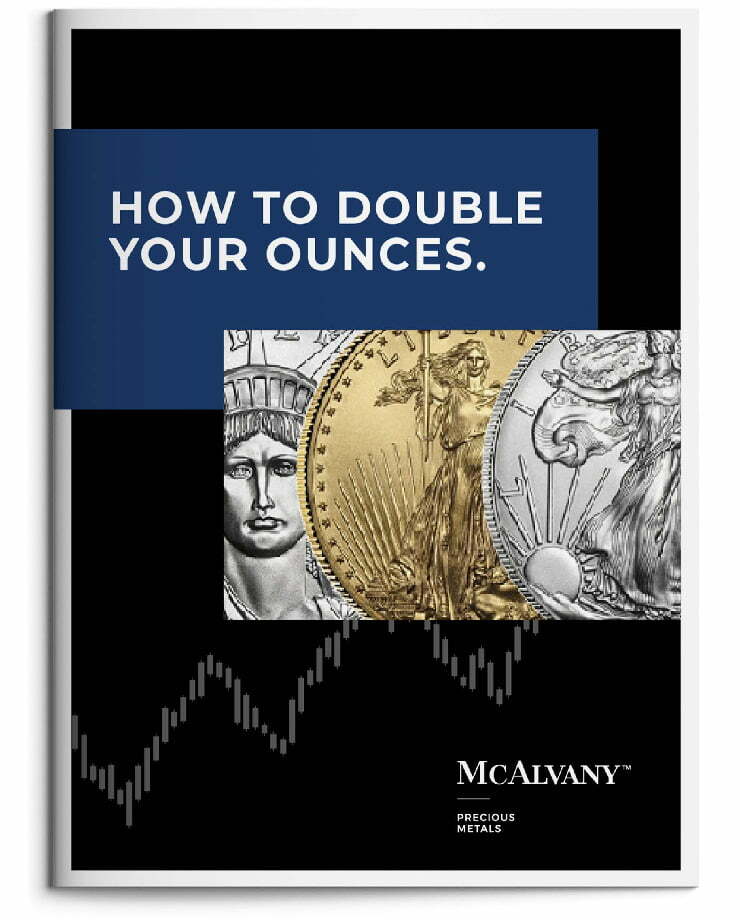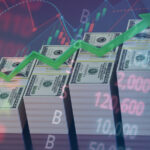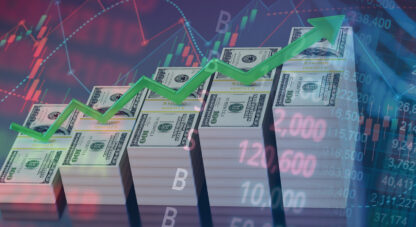In his argument for a July rate cut, Fed Governor Christopher Waller states that “tariffs are one-off increases in the price level and do not cause inflation beyond a temporary surge.” Moreover, “a host of data argues that monetary policy should be close to neutral, not restrictive.” “The [GDP and employment] data imply the policy rate should be around neutral, which the median of FOMC participants estimates is 3%, and not where we are—1.25 to 1.50 percentage points above 3%.”
The Atlanta Fed GDPNow Forecast has Q3 growth up around 2.4%, a notable acceleration from the first half. As for the labor market, June’s Unemployment Rate dipped a tenth to a historically low 4.1% (hasn’t been lower since January). Data suggests labor market tightening. Weekly Jobless Claims dropped last week to a three-month low of 221,000. The most recent (May) JOLTS data surprised with a hefty (almost 400k) jump in job openings to a six-month high of 7.769 million.
July 14 – Bloomberg (Rachel Graf): “Companies rushed to tap the US leveraged-loan market for debt on Monday, leading to the market’s busiest day since January. The week kicked off with 19 leveraged-loan launches, worth about $24 billion… That’s the most since Jan. 21, when more than 30 firms tapped the market for $48 billion of debt.”
More evidence this week that notably loose financial conditions are working their magic. Bloomberg: “Retail Sales Surge in Broad Advance, Topping Estimates.” Retail Sales were up 0.6% (expectations 0.1%) for the month and 3.3% y-o-y. Empire Manufacturing and the Philadelphia Fed Business Outlook were much stronger-than-expected, with Industrial Production and Capacity Utilization above expectations. Housing Starts and Building Permits beat forecasts. University of Michigan Current Conditions gained two points to a stronger-than-expected 66.8, up nearly eight points in two months to the highest reading since January. For comparison, Current Conditions were at 62.7% last July.
Inflation data, as it has lately, offered something for everyone. June headline CPI was reported at 0.3%, up from May 0.1% – placing y-o-y CPI at a four-month high of 2.7%. “Core” CPI added a tenth to a four-month high of 2.9%. Axios: “Trump’s trade war begins to show up in inflation data.” JPMorgan: “June 2025 CPI report: Tariffs are having an impact on consumer prices.” NYT: “U.S. Inflation Accelerated in June as Trump’s Tariffs Pushed Up Prices – Prices of products most exposed to tariffs, like household furnishings, jumped 1%, significantly higher than the 0.3 rise last month. Prices for appliances, specifically, rose 1.9%… The apparel index increased 0.4%, snapping multiple months of declining prices. Gasoline prices rose 1% in June… Grocery prices also rose, ticking up 0.3% in June.”
July 15 – Wall Street Journal (Editorial Board): “President Trump insists there is ‘no inflation’ as he bludgeons the Federal Reserve to cut interest rates. But denying inflation reality won’t make it go away. His tariffs are making it harder for the central bank to do what he wants, as last month’s rise in the consumer-price index shows. The… consumer-price report… showed inflation ticked up in June… Price increases were broad-based, and especially in goods that the U.S. imports. Think toys (1.8%), paper products (1.4%) and appliances (1.9%). The latter was the biggest increase since August 2020. Food prices rose 0.3% despite a 7.4% decline in egg prices. One culprit was fresh fruit and vegetables (1%), the biggest increase in more than a year. About 60% of fresh fruit and 35% of fresh vegetables are imported.”
As for tariffs, we’re in uncharted territory with great uncertainty. Especially with inflation exceeding the Fed’s 2% target for more than four years, it’s uncentral banker-like to dismiss inflation risk.
To argue a 3% “neutral rate” and currently overly restrictive monetary policy is a stretch. After an abrupt early-April (“liberation day”) tightening, financial conditions loosened dramatically throughout Q2. This was earnings week for the major “banks.” And when it comes to financial conditions, it is always Credit and financial sector expansions where the analytical rubber meets the road. Before highlighting some Q2 bank data for the largest banks, it’s important to appreciate the financial boom that had taken full control during Q1.
From Q1 Z.1 report analysis: Bank Assets jumped $581 billion, or 8.4% annualized, during Q1 to a record $28.388 TN – the largest quarterly growth since Q4 2021. Bank Assets ballooned $6.988 TN, or 33%, over 21 quarters. For Q1, Bank Loans increased $52 billion, or 1.4%, to a record $14.926 TN… Meanwhile, Repo Assets surged $84 billion, or 48% annualized (strongest since Q4 ‘18), to a record $782 billion – with one-year growth of $147 billion, or 23%. Bank Debt Securities holdings jumped $172 billion, or 11.2% annualized, to $6.342 TN. Debt Securities ballooned $1.660 TN, or 35.4%, over 21 quarters. Agency Securities holdings jumped $91 billion, or 11.9% annualized, with Corporate Bonds up $71 billion, or 31.9% annualized.”
A few of the week’s headlines: “US banking giants reap gains from dealmaking rebound, trading bump.” “For Big Banks, the Trump Era Is Proving Profitable Thus Far.” “JPMorgan Chase tops estimates on stronger-than-expected trading, investment banking.” “JPMorgan Earnings Show Economy and Wall Street Are Still Chugging Along.” “Goldman Sachs Profit Surges on Higher Trading Revenue.” “Citigroup beats second-quarter estimates as markets and banking revenues jump.” “Bank of America Reports Increase in Second-Quarter Profit.”
July 15 – New York Times (Rob Copeland and Stacy Cowley): “For years, Wall Street’s top bankers have watched with a mix of envy and exhaustion as power, profits and the popular imagination shifted westward to Silicon Valley. Being out of the spotlight, however, is proving profitable in the second Trump era. While many industries have been upended by the president’s topsy-turvy trade and immigration policies, Wall Street is quietly humming along just fine. Some of the biggest lenders in America reported strong quarterly earnings on Tuesday along with increasing — if tentative — optimism that the U.S. economy has more room to run. The reports were a reminder that in the world of high finance, uncertainty is often a chance to make money.”
July 16 – Bloomberg (Paul J. Davies): “Where are all of David Solomon’s critics now? Those who haven’t left Goldman Sachs Group Inc. for other firms are getting on with their jobs with gusto. The investment bank’s chief executive officer had a torrid time cleaning up his strategic misstep into consumer banking, but two years after ending that project, its core businesses are on fire. Goldman reported record equity trading revenue in second-quarter earnings… and trounced its peers with a rebound in investment banking revenue that was fueled by a 70% jump in deal-making fees versus the same period last year… In equities, Goldman reported record revenue of $4.3 billion, which was made up of fees from cash and derivatives trading as clients kept adjusting portfolios to the ups and downs of White House policy, along with record lending to hedge funds, too. The result keeps it ahead of nearest rivals Morgan Stanley and JPMorgan…”
July 16 – Bloomberg (Hannah Levitt): “Morgan Stanley’s stock traders scored their best second quarter on record as the biggest US banks continue to reap the benefits of market volatility tied to President Donald Trump’s policy moves. The firm earned $3.72 billion in equity-trading revenue, a 23% jump from a year ago and ahead of analyst expectations… The firm’s closely-watched wealth management unit reeled in $59.2 billion of net new assets in the period, also surpassing predictions.”
July 16 – Financial Times (Akila Quinio): “Bank of America notched up better than expected profits in the second quarter as the US lender expanded its deposit base and loan book and benefited from robust Wall Street trading activity. The group’s net income rose about 3% to $7.1bn, exceeding analyst expectations of $6.8bn. Revenues rose 4% to $26.5bn, slightly missing forecasts of $26.7bn. Revenues at the retail bank rose 6% to $10.8bn as the group grew its deposit base and loan book and benefited from higher net interest income…”
Bank earnings analysis is fine, but balance sheets are where the action is at. JPMorgan Total Assets surged $194.6 billion, or 18% annualized, to a record $4.552 TN during the quarter. This put first-half growth at a staggering $549.7 billion, or 27.5%. Total Loan growth accelerated to $56.3 billion, or 16.6% annualized – with first-half growth of $64.0 billion, or 9.5% annualized. Total Commercial Loan growth accelerated to $43.8 billion, or 23.7% annualized, to a record $785 billion (1st-half $62.7bn, or 17.4% annualized). Total Consumer Loan growth accelerated to $12.5 billion, or 8.1% annualized, to a record $627 billion (1st-half $1.3bn, or 0.4% annualized).
“Fed Funds Sold & Repos” jumped $41.1 billion, or 38% annualized, to a record $470.6 billion – with first-half growth of $175.6 billion, or 120% annualized. Short-Term and Long-Term Investments surged $96.3 billion, or 26% annualized, to a record $1.575 TN, pushing first-half growth to $317 billion, or 50% annualized. The asset “Trading Securities” posted first-half growth of $252.7 billion, or 88% annualized, to a record $829.5 billion.
“Other Assets” jumped $29.0 billion, or 39% annualized, to a $326 billion – with first-half growth of $63.3 billion, or 28% annualized.
On the Liability side, Total Deposits expanded $66.5 billion, or 10.7% annualized, to a record $2.562 TN – with first-half growth of $156.3 billion, or 13.0% annualized. “Short-Term Borrowings and Repos” surged $86.0 billion, or 46% annualized, to a record $833.9 billion – with notable first-half growth of $329.3 billion, or 130% annualized. Category detail will follow, but it’s worth noting that “Securities Sold Under Repo” ballooned an unprecedented $180 billion during Q1 to a record $834 billion. “Trading Account Liabilities” surged $23.4 billion during Q2, or 63% annualized, to $173 billion.
Bank of America Total Asset growth of $91.7 billion, or 11% annualized, to a record $3.441 TN, pushed first-half growth to $179.6 billion, or 11% annualized. Total Loan growth accelerated to $35 billion, or 12.5% annualized, with first-half growth of $47.1 billion, or 8.5% annualized. Total Commercial Loan growth accelerated to $31.7 billion, or 19.7% annualized (to a record $674bn), with first-half growth of $43.4 billion, or 13.8% annualized. Total Consumer Loan growth increased to $4.8 billion, or 4.1% annualized (to $473bn), with first-half growth of $7.8 billion, or a 3.3% rate.
The asset “Fed Funds Sold & Repos” posted growth of $24 billion, or 29.3% annualized to $352 billion, with first-half growth of $77.7 billion, or 57% annualized.
On the Liability side, Total Deposits grew $22 billion, or 4.4% annualized, with first-half growth of $46.1 billion, or 4.7% annualized. “Short-Term Borrowings & Repos” surged $31.8 billion, or 24.3% annualized, to a record $555 billion – with first-half growth of $85.3 billion, or 36.3% annualized.
Citigroup Total Assets expanded $51.3 billion, or 8.0% annualized, during Q2 to a record $2.623 TN, boosting first-half growth to $269.8 billion, or 22.9%, annualized. Total Loans expanded $29.9 billion, or 15.7% annualized during Q2 and $44.0 billion, or 11.8% annualized, for the first half. Total Commercial Loans jumped $13.6 billion, or 17.2% annualized, with first-half growth of $28.4 billion, or 18.9% annualized. Total Consumer Loans expanded $9.7 billion, or 10.0% annualized during Q2 – and $2.4 billion, or 1.2% annualized, during the first half.
On the Liability side, Total Deposits surged $41.3 billion, or 12.6% annualized, during Q2, with first-half growth of $73.3 billion, or 11.4% annualized. “Short-Term Borrowings & Repos” expanded $27.8 billion, or 17.6% annualized, during the quarter – and $202.3 billion, or 89% annualized, during the first half. Q2 detail to follow, but “Securities Sold Under Repo” ballooned $146.5 billion during Q1 to $386 billion.
The NYSE Broker/Dealer Index (XBD) surged 3.8% this week, boosting 2025 returns to 29.8%. It is simply not credible to argue that monetary policy is restrictive or that the Fed should aggressively slash interest rates. The administration’s attack on Powell is borderline despicable.
July 16 – Bloomberg (Lucia Mutikani): “President Donald Trump said he’s not planning to fire Jerome Powell, and still managed to make it sound like a threat. Trump’s comments capped a hectic few hours that took his pressure campaign against the Federal Reserve chief to a new level — and sent markets into a shortlived nosedive. He ran the idea of sacking Powell by a receptive group of Republican lawmakers late Tuesday. An aide said Wednesday morning he was likely to follow through. Then the president publicly backpedaled – with a major caveat. ‘I don’t rule out anything, but I think it’s highly unlikely, unless he has to leave for fraud,’ Trump said Wednesday when asked about axing the Fed chair.”
July 17 – Associated Press (Christopher Rugaber): “Federal Reserve Chair Jerome Powell… said the agency’s renovation of two of its buildings is in compliance with plans approved by a local commission, disputing a White House suggestion that they may have violated the law by deviating from those plans. The letter is the latest salvo in an escalating battle between the Federal Reserve, an independent agency charged with fighting inflation and seeking maximum employment, and the Trump administration… Vought said in his letter that if the renovation plans had changed, they were no longer ‘in compliance with the approved plan’ and may violate the National Capital Planning Act. Powell responded… that since the Fed’s plans were approved by the NCPC in September 2021, it has made only ‘a small number of design changes to scale back or eliminate certain elements’ and added that the changes weren’t significant enough to ‘warrant… further review.’ ‘The project is proceeding in accordance with the plan that the NCPC approved,’ Powell wrote. The changes were intended ‘to simplify construction and reduce the likelihood of further delays and cost increases,’ Powell said in his letter.”
I refer to the “global government finance Bubble” for good reason. It’s worth noting that China’s state-directed banks increased total assets $1.915 TN during Q1 to a record $63.920 TN, the strongest growth in two years. This pushed one-year growth to over $4.0 TN, or 6.7%.
Quietly, China is pumping out record quantities of (globally impactful) Credit. Aggregate Financing, China’s metric for system Credit, expanded a stronger-than-expected $586 billion during June, up from May’s $319 billion and June ‘24’s $460 billion. First-half growth of $3.185 TN was up 26% from comparable 2024. Record one-year growth of $5.159 TN exceeds even pandemic 2020’s $4.852 TN. Historic Credit expansion belies all the China deflation talk.
Corporate Loan growth of $246 billion (up 8.9% y-o-y) was up from May’s $75 billion and June ‘24’s $227 billion, with first-half growth of $1.608 TN up 5% from comparable 2024. Consumer Loans increased $83 billion (up 3.0% y-o-y), up from May’s $8 billion and June ‘24’s $80 billion. Government Bonds surged $188 billion for the month, easily surpassing June ‘24’s $119 billion. Year-to-date growth of $1.067 TN more than doubled comparable 2024. Record one-year growth of $2.177 TN compares to pandemic 2020’s $1.162 TN.
Vulnerable global bond markets will closely monitor Sunday’s national elections in Japan.
July 15 – Wall Street Journal (Ronnie Harui): “Growing fears that Japan’s upcoming parliamentary election will strain its fiscal position sent yields on long-dated government bonds sharply higher. Markets are fretting the Upper House election on July 20 could strip the ruling coalition of its majority and spur an increase in fiscal spending, one that might be financed by more bond issuance. The 20-year yield on Japanese government debt rose 4.5 bps to 2.650% early on Tuesday, its highest since November 1999… The 30-year yield rose 4.0 bps to a record high of 3.195%, while the 10-year yield rose 2.5 bps to 1.595%, the highest since October 2008. Market participants seem to be bracing for election scenarios that could have a major impact on the Japanese government bond market, such as consumption-tax cuts, Ataru Okumura, senior Japan rates strategist at SMBC Nikko Securities, said…”
July 14 – Bloomberg (Masaki Kondo): “Japan’s bond market is facing a potential Liz Truss moment as the risk of a ruling coalition defeat in Sunday’s election fuels concerns over fiscal policy, according to SMBC Nikko Securities Inc. Yields on bonds with maturities of 20 years and beyond have risen at least 20 bps this month, part of a wave of selling in global bond markets as investors increasingly worry about government finances. That has put the spotlight on a weekend election for Japan’s upper house, which local media think may end in disappointment for the ruling Liberal Democratic Party and its coalition partner. Rival political parties have campaigned on populist promises including cash handouts, consumption tax cuts and more subsidies for education. These pledges raise the risk of heavy selling by so-called bond vigilantes…”
For the Week:
The S&P500 added 0.6% (up 7.1% y-t-d), while the Dow was little changed (up 4.2%). The Utilities gained 1.5% (up 11.2%). The Banks increased 0.3% (up 12.8%), and the Broker/Dealers jumped 3.8% (up 29.1%). The Transports dropped 2.1% (down 0.2%). The S&P 400 Midcaps were unchanged (up 1.6%), and the small cap Russell 2000 increased 0.2% (up 0.4%). The Nasdaq100 rallied 1.3% (up 9.8%). The Semiconductors added 0.6% (up 15.1%). The Biotechs dropped 2.7% (down 2.2%). With bullion down $6, the HUI gold index fell 2.1% (up 52.8%).
Three-month Treasury bill rates ended the week at 4.225%. Two-year government yields slipped two bps to 3.87% (down 37bps y-t-d). Five-year T-note yields fell three bps to 3.95% (down 44bps). Ten-year Treasury yields added a basis point to 4.42% (down 15bps). Long bond yields increased four bps to 4.99% (up 21bps). Benchmark Fannie Mae MBS yields added two bps to 5.67% (down 17bps).
Italian 10-year yields dipped two bps to 3.55% (up 3bps y-t-d). Greek 10-year yields slipped a basis point to 3.38% (up 16bps). Spain’s 10-year yields declined two bps to 3.31% (up 25bps). German bund yields dipped three bps to 2.70% (up 33bps). French yields declined two bps to 3.40% (up 21bps). The French to German 10-year bond spread narrowed one to 70 bps. U.K. 10-year gilt yields rose five bps to 4.67% (up 11bps). U.K.’s FTSE equities index increased 0.6% (up 10.0% y-t-d).
Japan’s Nikkei 225 Equities Index added 0.6% (down 0.2% y-t-d). Japanese 10-year “JGB” yields gained two bps to 1.54% (up 44bps y-t-d). France’s CAC40 was little changed (up 6.0%). The German DAX equities index was about unchanged (up 22.0%). Spain’s IBEX 35 equities index was slightly negative (up 20.6%). Italy’s FTSE MIB index gained 0.6% (up 17.9%). EM equities were mixed. Brazil’s Bovespa index fell 2.1% (up 10.9%), and Mexico’s Bolsa index slipped 0.6% (up 13.7%). South Korea’s Kospi added 0.4% (up 32.9%). India’s Sensex equities index declined 0.9% (up 4.1%). China’s Shanghai Exchange Index increased 0.7% (up 5.5%). Turkey’s Borsa Istanbul National 100 index was little changed (up 5.4%).
Federal Reserve Credit declined $7.7 billion last week to $6.615 TN. Fed Credit was down $2.275 TN from the June 22, 2022, peak. Over the past 305 weeks, Fed Credit expanded $2.888 TN, or 77%. Fed Credit inflated $3.804 TN, or 135%, over the past 662 weeks. Elsewhere, Fed holdings for foreign owners of Treasury, Agency Debt fell $7.7 billion last week to $3.231 TN. “Custody holdings” were down $81 billion y-o-y, or 2.4%.
Total money market fund assets declined $7.3 billion to $7.065 TN. Money funds were up $921 billion, or 15.0%, y-o-y.
Total Commercial Paper declined $20.7 billion to $1.405 TN. CP has expanded $317 billion y-t-d and $110 billion, or 8.5%, y-o-y.
Freddie Mac 30-year fixed mortgage rates increased three bps to 6.75% (down 2bps y-o-y). Fifteen-year rates rose six bps to 5.92% (down 13bps). Bankrate’s survey of jumbo mortgage borrowing costs had 30-year fixed rates unchanged at 6.86% (down 35bps).
Currency Watch:
July 16 – Reuters (Yoruk Bahceli): “Central banks have ramped up buying at euro zone bonds sales this year… U.S. President Donald Trump’s confrontations with longstanding allies over trade and security, along with attacks on the Federal Reserve, have raised concerns around the safe- haven status of the U.S dollar, the world’s No.1 reserve currency, which has tumbled 9% this year… Official institutions, which include central banks and sovereign wealth funds, have bought a fifth of euro zone government debt sold at syndications year-to-date, up from 16% for the whole of last year, a Barclays analysis showed…”
July 14 – Bloomberg (Rachel Graf): “Traders in the $1.4 trillion junk bond market have had a record year: they’ve never traded this much per day, according an analysis by JPMorgan… Average trading volume for high-yield bonds has hit a record $17.1 billion a day so far this year, a 14% increase from trading volumes last year… Money managers are ramping up bulk bond purchases, as volatility has created an opening for quick trades. Every month this year, average daily trading volume has surpassed $15 billion, with the most recent quarter averaging $17.3 billion…”
For the week, the U.S. Dollar Index recovered 0.6% to 98.48 (down 9.2% y-t-d). For the week on the upside, the South African rand increased 1.3%. On the downside, the Swedish krona declined 1.1%, the Australian dollar 1.1%, the South Korean won 1.0%, the Japanese yen 0.9%, the New Zealand dollar 0.8%, the Norwegian krone 0.6%, the Mexican peso 0.6%, the Swiss franc 0.6%, the British pound 0.6%, the euro 0.5%, the Singapore dollar 0.4%, the Brazilian real 0.4%, and the Canadian dollar 0.3%. The Chinese (onshore) renminbi slipped 0.06% versus the dollar (up 1.74% y-t-d).
Commodities Watch:
July 15 – CNBC (Lee Ying Shan): “Central banks are increasingly looking to bolster their gold reserves. And they are turning to mines in their backyard to source the yellow metal. Besides being cheaper, securing gold directly from mines helps support local industry and bolsters reserves without weighing on foreign exchange reserves, experts said. While countries such as the Philippines and Ecuador have been doing this for years, more central banks with access to domestic gold mines have started, increased, or are considering direct local purchases, according to the World Gold Council.”
The Bloomberg Commodities Index gained 1.2% (up 6.4% y-t-d). Spot Gold slipped 0.2% to $3,350 (up 27.6%). Silver declined 0.6% to $38.175 (up 32.1%). WTI crude fell $1.11, or 1.6%, to $67.34 (down 6%). Gasoline dropped 1.5% (up 6%), while Natural Gas jumped 7.6% to $3.565 (down 1%). Copper was unchanged (up 32%). Wheat recovered 1.0% (down 1%), and Corn gained 1.4% (down 11%). Bitcoin added $800, or 0.7%, to $118,340 (up 26.3%).
Market Instability Watch:
July 13 – Wall Street Journal (Alexander Saeedy): “Jamie Dimon says Wall Street’s hottest trend is a recipe for a financial crisis, but he’s investing billions to get in on it anyway. His plan: swoop in strategically and profit if there’s a meltdown. In the ballroom of the swanky Loews Hotel in Miami Beach, Dimon got on stage in front of hundreds of clients in February to talk about the boom in unregulated lending to highly indebted companies. This fast-growing market has been sidelining big banks for years, and JPMorgan… chief executive said it reminded him of the craze in subprime mortgages that sparked the 2008 financial crisis. ‘Parts of direct lending are good,’ Dimon said… ‘But not everyone does a great job, and that’s what causes problems with financial products.’ He said that in the 2008 financial crisis, Bear Stearns and Lehman Brothers got in late, made bad choices and ‘bought these two sh—y little mortgage companies,’ leading eventually to ‘everything’ blowing up. The comparison was jarring. Just hours earlier, JPMorgan had announced it was investing $50 billion in private credit…”
July 15 – Bloomberg (Aashna Shah): “Municipal bonds sold off on Tuesday, with benchmark yields rising as much as eight bps, as new inflation data caused traders to par back expectations for an interest-rate cut in September. The yield on the 10-year muni benchmark rose eight bps to 3.25% in the market’s worst day since tariff-fueled volatility in April. US Treasuries also sold off…, which signaled that companies are beginning to more meaningfully pass some tariff-related costs to consumers.”
July 14 – Reuters (Gertrude Chavez-Dreyfuss): “More than $1 trillion in U.S. short-term bills are expected to flood the market over the next 1-1/2 years following the increase in the debt ceiling, as the Treasury replenishes its diminished cash balance while funding the country’s huge fiscal deficit. There is, however, no shortage of buyers, with money market funds leading the way. Armed with a record $7.4 trillion in assets as of July 1, money funds, which invest in short-term, low-risk securities such as Treasury bills and repurchase agreements, or repos, are ready to take on more supply.”
July 15 – CNBC (Spencer Kimball): “The Pentagon is taking immediate action to boost critical mineral production in the U.S. and counter China’s dominance of the supply chain for rare earth magnets, a defense official told CNBC… The Defense Department last week agreed to buy a direct equity stake in MP Materials… MP operates the only rare earth mine in the U.S. located at Mountain Pass, California, and a magnet plant in Fort Worth, Texas. When asked whether the Pentagon is considering similar investments in other U.S. mining companies, the defense official said it is looking at opportunities to strengthen domestic critical mineral production. ‘Rebuilding the critical minerals and rare earth magnet sectors of the U.S. industrial base won’t happen overnight, but DoD is taking immediate action to streamline processes and identify opportunities to strengthen critical minerals production,’ official said…”
Global Credit and Financial Bubble Watch:
July 17 – Bloomberg (Rachel Graf): “The number of companies at the greatest risk of defaulting are at an 11-month high, as uncertainty around US trade and tariffs worsened credit conditions, according to a Moody’s Ratings report. In the second quarter, 16 companies were added to the cohort of businesses with the highest default risk… The group now stands at 241 companies, the report shows. ‘With US tariffs and trade uncertainty unsettling global commerce in April, credit conditions have deteriorated’ since the beginning of the year, the analysts wrote.”
July 12 – Bloomberg (Rachel Graf and Caleb Mutua): “Credit rating downgrades are becoming more frequent, the latest sign that companies are starting to perform worse and raising fresh questions about whether corporate debt valuations should be as high as they are. In the second quarter, around $94 billion of high-grade US debt was downgraded, compared with just $78 billion of upgrades, according to JPMorgan… It was the first time since early 2021 that downgrades outpaced upgrades in dollar terms, and more companies are at risk of being demoted later this year as economic uncertainty rises, JPMorgan strategists… wrote this week.”
July 16 – Bloomberg (Sri Taylor): “President Donald Trump’s budget bill has municipal-bond investors bracing for mounting financial strains on hospitals and health-care systems amid estimates that the legislation could push millions of Americans off their health insurance. Trump’s $3.4 trillion tax and spending package makes substantial cuts to Medicaid, the public health-insurance program for low-income and disabled people. Republicans are also mulling deeper reductions to Medicaid in a follow-up bill.”
July 16 – Bloomberg (Tasos Vossos): “Debt bankers and investors are bracing for what is shaping up to be the next big trend in the global credit market: Japan Inc. raising billions abroad. A string of recent megadeals is setting the tone. A giant sale by telecom giant NTT Inc. has already driven Japanese non-financial corporate issuance in euros and dollars to a record this year… Japanese companies are heading overseas to borrow as their local market is becoming too volatile and rates are rising. They are finding there is buoyant demand for credit among dollar and euro investors in much deeper and more stable pools of capital.”
Trump Administration Watch:
July 16 – Bloomberg (Amara Omeokwe): “President Donald Trump is on a relentless campaign to pressure the Federal Reserve into cutting interest rates, renewing the question of how much a US president can and should influence an institution designed to be independent. The Fed’s decision to hold interest rates steady so far this year has deeply angered Trump. He’s questioned the central bank’s decision making and regularly lambasted Chair Jerome Powell, sometimes on a daily basis, calling him ‘very dumb’ and one of the ‘most destructive’ people in government. Some administration officials appear to be building a case that Powell’s handling of matters related to the renovation of the Fed’s headquarters offers Trump an opportunity to meet the high legal standard required to remove the central bank chief.”
July 16 – Associated Press (Christopher Rubager and Josh Boak): “President Donald Trump says he has finally found a way to achieve his goal of removing Federal Reserve Chair Jerome Powell, accusing him of mismanaging the U.S. central bank’s $2.5 billion renovation project. It’s unclear if Trump will follow through, but he has been outspoken about wanting Powell gone. The push comes after a monthslong campaign by Trump to try to rid himself of the politically independent central banker… Trump indicated… Powell’s handling of an extensive renovation project on two Fed buildings in Washington could be grounds to take the unprecedented and possibly legally dubious step of firing him. ‘I think it sort of is,’ Trump said.”
July 13 – Reuters (David Lawder): “U.S. President Donald Trump has the authority to fire Federal Reserve Chair Jerome Powell for cause if evidence supports that, White House economic adviser Kevin Hassett said… and that the Fed ‘has a lot to answer for’ on renovation cost overruns at its Washington headquarters. Hassett told ABC’s ‘This Week’ program that any decision by Trump to try to fire Powell over what the Trump administration calls a $700 million cost overrun ‘is going to depend a lot on the answers that we get to the questions that Russ Vought sent to the Fed’… Hassett’s comments confirm that the Trump administration is actively exploring the renovation costs and Powell’s testimony about the project as a possible avenue to try to fire the Fed chief well before his term as chair ends in May 2026.”
July 15 – Reuters (Daniel Flatley, Annmarie Hordern, Jonathan Ferro and Lisa Abramowicz): “US Treasury Secretary Scott Bessent suggested that Federal Reserve Chair Jerome Powell should step down from the central bank’s board when his term as chair is up in May 2026. ‘Traditionally, the Fed chair also steps down as a governor,’ Bessent said… ‘There’s been a lot of talk of a shadow Fed chair causing confusion in advance of his or her nomination. And I can tell you, I think it’d be very confusing for the market for a former Fed chair to stay on also.’ Powell’s term as a Fed governor doesn’t end until January 2028, leaving it possible for him to remain at the central bank — and to participate in monetary policymaking — even after his tenure as the chair comes up next May.”
July 13 – CNBC (Erin Doherty): “National Economic Council Director Kevin Hassett said Sunday that whether the Trump administration has the authority to fire Federal Reserve Chair Jerome Powell is ‘being looked into.’ ‘But certainly, if there’s cause, he does,’ Hassett said… of President Donald Trump’s authority to remove Powell before his term is up next spring.”
July 15 – Bloomberg (Nancy Cook and Catarina Saraiva): “Kevin Hassett, one of President Donald Trump’s longest-serving economic aides, is the early frontrunner to replace Jerome Powell as Federal Reserve chief next year… Hassett, director of the National Economic Council, and Kevin Warsh are the top two contenders in an Apprentice-like contest run by Trump out of the White House. Treasury Secretary Scott Bessent is advising on selection — but could get the job himself if others fail to impress — while Fed governor Christopher Waller remains the dark horse, said people familiar… Hassett has echoed Trump’s Fed critique. In a Fox Business interview… he noted that the central bank is an independent agency. But he said that by cutting rates before last year’s presidential election — and then keeping them on hold more recently, citing inflation risk from tariffs – it deserved the president’s barbs. ‘I think that that raises the specter that they’re not being non-partisan, they’re not being independent,’ Hassett said.”
July 14 – The Hill (Tobias Burns): “The possibility that President Trump could replace Federal Reserve Chair Jerome Powell with Treasury Department Secretary Scott Bessent is spinning heads from Washington to Wall Street and beyond. Senators on both sides of the aisle have thrown cold water on the idea despite rising tension between Trump and Powell over interest rates, and the precedent-breaking move could also rock markets and face legal challenges… Legal experts say there’s no law preventing the Treasury secretary from also serving as the chair of the Federal Reserve. ‘There’s no prohibition in the Federal Reserve Act that says a member of the board of governors, or the chair, can’t also be the Secretary of the Treasury,’ Sarah Binder, a senior fellow at the Brookings Institution, told The Hill.”
July 15 – Bloomberg (Jennifer A Dlouhy): “President Donald Trump said Scott Bessent was an option to replace Jerome Powell as head of the Federal Reserve but suggested the Treasury secretary was not the leading candidate because of his success in his current role. ‘He’s an option and he’s very good,’ Trump told reporters on Tuesday when asked directly about Bessent being a potential successor. Asked by a reporter whether Bessent was the top option, Trump responded, ‘Well, he’s not, because I like the job he’s doing.’”
July 14 – CNBC (Kevin Breuninger): “White House economic advisor Kevin Hassett speculated… that new tariff policies are not yet sparking widespread price inflation because President Donald Trump has convinced more people to buy American. ‘There’s, I think, a lot of patriotism in the data,’ Hassett said… when he was asked to explain why Trump’s protectionist policies have not stoked higher prices, despite warnings by many economists. The National Economic Council director pointed to a recent White House report, which found prices of imported goods fell between December and May. ‘My theory, as an economist, of why that is, is that Americans, because of President Trump’s leadership, have recognized that when they buy an American product, they not only get perhaps a better product, certainly a better product most of the time, but they’re also making their community stronger,’ Hassett said.”
July 11 – Politico (Michael Schaffer): “On Wednesday night, President Donald Trump ousted Joe Biden’s appointees to the National Capital Planning Commission, the obscure panel that oversees urban planning for the Washington area. And instead of the usual wonky architecture types, the replacements are sharply political White House heavyweights: Staff Secretary Will Scharf, Deputy Chief of Staff James Blair and Stuart Levenbach, an aide to Office of Management and Budget chief Russell Vought. On the face of it, it seemed like a strange use of senior officials’ time. At their inaugural meeting Thursday, the three sat through an afternoon of discussions about lighting plans for a Smithsonian building and guidelines for protecting pollinating insects. But their presence made a lot more sense when the new commissioners spoke up — and promptly took aim at one of Trump’s political foes, Federal Reserve Chair Jerome Powell.”
July 13 – The Hill (Filip Timotija): “White House senior trade adviser Peter Navarro touted ‘Trumpnomics’ in a recent interview during a rant against Jerome Powell, slamming the Federal Reserve chair as a ‘pure partisan’ actor who… is holding back the economy. ‘So, here’s the deal. It’s like in the first term, when President Trump was in, Powell gets up to the chair, and the first thing he starts doing is raising rates, because he doesn’t understand how powerful Trumpnomics is and be able to generate strong growth without generating inflation… He cost this country a full point of growth per year, which is just a lot of jobs, close to a million jobs,’ he added. ‘It’s billions of dollars in tax revenues and so things. And then second, when he’s in with Biden in order to get reappointed, he cozies up the Biden, pure partisan political c—, and he doesn’t raise interest rates when Biden and then, God, the Democrat Congress are spending money like drunken sailors, driving the inflation rate. Not taking care of supply chains.’”
July 14 – Bloomberg (Gerard Baker): “Our conspiracy-minded, deep-state-vigilant president has suggested that there is no great scandal surrounding the life and death of Jeffrey Epstein, but there is a Jerome Powell scandal. While we are assured that Mr. Epstein’s long history of ties to politicians, royals, Wall Street figures and others stemmed only from the man’s generous hospitality, magnetic personality and promise of evenings of Socratic interlocution, Mr. Powell’s sin is to be the first bureaucrat in history to oversee large overruns in a construction budget.”
China Trade War Watch:
July 15 – CNBC (Kif Leswing): “Commerce Secretary Howard Lutnick… said the Trump administration reversed course on allowing Nvidia to sell its AI chips to China because the U.S. company will not be giving over its best technology. Lutnick made the remark speaking with CNBC’s Brian Sullivan, saying that Nvidia wants to sell China its ‘fourth best’ chip, which is slower than the fastest chips that U.S. companies use. ‘We don’t sell them our best stuff, not our second best stuff, not even our third best,’ Lutnick said. Nvidia said… it would soon resume sales of the H20 chip to China after the Trump administration signaled that it would grant the chipmaker necessary export licenses.”
July 17 – Bloomberg (Tope Alake, Gabrielle Coppola and Annie Lee): “The US Commerce Department imposed preliminary anti-dumping duties of 93.5% on Chinese imports of graphite, a key battery component, after concluding the materials had been unfairly subsidized.”
Trade War Watch:
July 13 – Reuters (Jarrett Renshaw, Bhargav Acharya and Cassandra Garrison): “President Donald Trump… threatened to impose a 30% tariff on imports from Mexico and the European Union starting on August 1, after weeks of negotiations with the major U.S. trading partners failed to reach a comprehensive trade deal. In an escalation of a trade war that has angered U.S. allies and rattled investors, Trump announced the latest tariffs in separate letters to European Commission President Ursula von der Leyen and Mexican President Claudia Sheinbaum that were posted on his Truth Social media site on Saturday.”
July 16 – Bloomberg (Josh Wingrove, Kate Sullivan and Hadriana Lowenkron): “President Donald Trump said he would send letters to more than 150 countries notifying them their tariff rates could be 10% or 15% as he forges ahead with his trade agenda. ‘We’ll have well over 150 countries that we’re just going to send a notice of payment out, and the notice of payment is going to say what the tariff’ rate will be, Trump told reporters… ‘It’s all going to be the same for everyone, for that group,’ Trump added, saying that the trading partners that would receive those letters were ‘not big countries, and they don’t do that much business.’”
July 14 – Wall Street Journal (Kim Mackrael): “The European Union is readying a fresh list of American products—ranging from aircraft to alcoholic beverages, coffee and medical devices—to hit with retaliatory tariffs if a trade deal isn’t reached by President Trump’s Aug. 1 deadline. EU officials… unveiled the list after Trump’s latest tariff threat over the weekend revived a debate in the bloc over whether it should fight back, and how forcefully, if the two sides can’t reach a deal. The EU in April froze an initial package of retaliatory tariffs against the U.S. after Trump said he would limit blanket tariffs on most countries to 10% for 90 days. The new EU list… covers American imports that were together valued at roughly $84 billion last year. The list covers about $77 billion worth of industrial imports, including aircraft, machinery, automotive products, chemicals, plastics and medical devices. It also covers about $7 billion worth of agricultural and food products, such as fruits and vegetables, wine, beer and spirits.”
July 15 – Bloomberg (Lionel Laurent): “‘C’mon, do something.’ The meme of a cartoon figure poking a dead fish with a stick could apply to the European establishment in these strained trade-war times. Just days after a collective sigh of acceptance in Brussels that US blanket tariffs of around 10% were inescapable, trade officials are belatedly scrambling after President Donald Trump’s latest threat of 30%, which would likely spell recession for the euro area. A bullying tactic it may be — and one that would draw counter-tariffs on €72 billion ($84bn) of goods including Boeing Co. aircraft — but it shows how cowed the mood has become even as Germany heads for a zero-growth year and France struggles to tame its deficit.”
July 14 – Financial Times (Andy Bounds): “There is ‘a big gap’ between the EU and US on tariffs ahead of an August deadline to strike a trade deal, the EU’s lead negotiator has warned. Maroš Šefčovič’s comments came after Donald Trump warned over the weekend that he would impose tariffs of 30% on the EU from August 1. ‘We’ve been quite close in agreeing the text on the [trade] agreement in principle, but there have been clearly areas where we have quite a big gap between our two positions,’ Šefčovič said… He had earlier warned that tariffs of 30% on EU imports would make transatlantic trade ‘almost impossible’.”
July 15 – Bloomberg (Jennifer A Dlouhy and Justin Sink): “President Donald Trump said he was likely to impose tariffs on pharmaceuticals as soon as the end of the month and that levies on semiconductors could come soon as well, suggesting that those import taxes could hit alongside broad ‘reciprocal’ rates set for implementation on Aug. 1. ‘Probably at the end of the month, and we’re going to start off with a low tariff and give the pharmaceutical companies a year or so to build, and then we’re going to make it a very high tariff,’ Trump told reporters… Trump on Tuesday predicted that he could strike ‘two or three’ trade deals with countries before implementing his so-called reciprocal tariffs before they are implemented on Aug. 1, saying that an agreement with India was among the most likely.”
July 15 – Bloomberg (Daniel Carvalho): “Most Brazilians see Donald Trump’s threat of a 50% tariff as unjustified meddling in internal affairs and believe President Luiz Inacio Lula da Silva’s administration is responding appropriately, according to a new poll. The survey, conducted by AtlasIntel for Bloomberg News…, found that 50.3% of respondents view Trump’s move — which the US leader linked to legal proceedings against former President Jair Bolsonaro — as an attack on Brazil’s sovereignty. After the US president’s July 9 threat, Lula said his government would respond in kind if tariffs go into effect on Aug. 1 as planned. Some 44.8% of Brazilians considered that reaction appropriate, 27.5% viewed it as aggressive, and 25.2% found it weak…”
July 15 – Bloomberg (Daniel Carvalho): “Most Brazilians see Donald Trump’s threat of a 50% tariff as unjustified meddling in internal affairs and believe President Luiz Inacio Lula da Silva’s administration is responding appropriately, according to a new poll. The survey, conducted by AtlasIntel for Bloomberg News…, found that 50.3% of respondents view Trump’s move — which the US leader linked to legal proceedings against former President Jair Bolsonaro — as an attack on Brazil’s sovereignty. After the US president’s July 9 threat, Lula said his government would respond in kind if tariffs go into effect on Aug. 1 as planned. Some 44.8% of Brazilians considered that reaction appropriate, 27.5% viewed it as aggressive, and 25.2% found it weak…”
July 15 – Bloomberg (Hadriana Lowenkron, Catherine Lucey and Claire Jiao): “President Donald Trump said he reached a deal with Indonesia that will tariff its goods at 19%, adding that the Southeast Asian nation agreed to erase all duties on US imports and buy more than $19 billion of American products including 50 Boeing Co. jets. ‘We are going to have full access to Indonesia,’ Trump told reporters… ‘They are paying 19% and we are not paying anything.’”
July 13 – Wall Street Journal (Kim Mackrael): “America’s biggest trading partners have tried tactics ranging from appeasement to retaliation to avoid higher tariffs. Most have come away bruised and empty-handed. Mexico took President Trump’s drug-enforcement demands seriously and boosted security measures. The European Union paused retaliation plans to focus on trade talks. Canada hit back with tariffs several months ago before shifting to a more conciliatory approach. All are faced with tariffs that have risen sharply since Trump took office. This past week he threatened most of them with further escalation.”
Budget Watch:
July 12 – Wall Street Journal (Richard Rubin): “Congress expanded opportunities for taxpayers to postpone, minimize or avoid capital-gains taxes in President Trump’s new tax law, giving boosts to investors without cutting the headline rate. While Trump-era Republicans have cut taxes on wages, business income, corporations and estates, they have left the top capital-gains rate exactly where it sat on Jan. 1, 2013: 23.8%. Behind that stasis, however, Congress continued shrinking the capital-gains tax base. In the tax-and-spending legislation that Trump signed into law July 4, Republicans reupped the Opportunity Zone tax break for investments in low-income areas and made it permanent, letting investors defer and reduce taxes. They also expanded a break often used by venture-capital investors that can wipe out capital-gains taxes when a startup is sold.”
Constitution Watch:
July 17 – Associated Press (Kimberly Kindy and Amanda Seitz): “Immigration and Customs Enforcement officials will be given access to the personal data of the nation’s 79 million Medicaid enrollees, including home addresses and ethnicities, to track down immigrants who may not be living legally in the United States… The information will give ICE officials the ability to find ‘the location of aliens’ across the country, says the agreement signed Monday between the Centers for Medicare and Medicaid Services and the Department of Homeland Security.”
U.S./Russia/China/Europe/Iran Watch:
July 15 – Bloomberg (Bingyan Wang): “Chinese President Xi Jinping meets Russian Foreign Minister Sergei Lavrov in Beijing…, and calls for deepening partnership between two countries, the official Xinhua News Agency reports… Xi calls for improving mechanisms for responding to security threats and challenges. Xi urges SCO members to resolutely oppose hegemony and Bullying.”
July 17 – Wall Street Journal (Costas Paris and Jack Pitcher): “China’s government is threatening to block a deal that would transfer ownership of dozens of seaports to Western investors if Cosco, China’s largest shipping company, doesn’t get a stake… China is pushing for state-owned Cosco to be an equal partner and shareholder of the ports with BlackRock and Mediterranean Shipping Co., a containership operator…”
July 13 – Wall Street Journal (Austin Ramzy and Emma Brown): “China’s military is extending its reach deeper into the Pacific, sending ships and aircraft into new territory in a push that has spurred the U.S. to strengthen defenses and alliances in the region. Beijing has long resented what it sees as interference by the U.S. and its allies in its traditional sphere of influence in the Asia-Pacific region. Now, it is asserting itself more aggressively in its backyard while also pushing well beyond longstanding geographical limits of its military. In response, the U.S. and its allies are dispersing military assets more widely so that they can respond better in case of a clash with China. The U.S. is also pressing its Asian partners to bolster their own defenses.”
July 13 – Financial Times (Demetri Sevastopulo): “The Pentagon is pressing Japan and Australia to make clear what role they would play if the US and China went to war over Taiwan, in an effort that has frustrated the two most important American allies in the Indo-Pacific. Elbridge Colby, US under-secretary of defence for policy, has been pushing the issue in meetings with Japanese and Australian defence officials in recent months… The push is his latest effort to convince US allies in the Indo-Pacific to enhance deterrence and prepare for a potential war over Taiwan.”
July 12 – Associated Press (Hyung-Jin Kim): “Russia’s foreign minister warned the U.S., South Korea and Japan against forming a security partnership targeting North Korea as he visited his country’s ally for talks on further solidifying their booming military and other cooperation. Russian Foreign Minister Sergey Lavrov spoke… at North Korea’s eastern Wonsan city, where he met the country’s leader, Kim Jong Un… Kim… reaffirmed his government’s commitment to ‘unconditionally support and encourage all measures’ taken by Russia in its conflict with Ukraine. He said Pyongyang and Moscow share identical views on ‘all strategic issues in conformity with the level of alliance,’ according to North Korea’s official Korean Central News Agency.”
Ukraine War Watch:
July 14 – Financial Times (Steff Chávez, Aime Williams, Christopher Miller and Laura Pitel): “Donald Trump has threatened Russia with ‘severe tariffs and other financial penalties if the war in Ukraine does not end soon, as he pledged to send more weapons to Kyiv through Nato allies. During a meeting in the Oval Office with Nato secretary-general Mark Rutte…, the US president said he was ‘very unhappy’ with Moscow over the lack of progress towards a deal to end the conflict. ‘We are very unhappy — I am — with Russia,’ Trump said. ‘I’m disappointed in President [Vladimir] Putin, because I thought we would have had a deal two months ago.’ ‘We’re going to be doing very severe tariffs if we don’t have a deal in 50 days, tariffs at about 100%, you’d call them secondary tariffs,’ he added. The tariffs would be ‘biting’ and ‘very, very powerful’.”
July 15 – Financial Times (Christopher Miller, Henry Foy, Max Seddon and Lauren Fedor): “Donald Trump has privately encouraged Ukraine to step up deep strikes on Russian territory, even asking Volodymyr Zelenskyy whether he could strike Moscow if the US provided long-range weapons, according to people briefed on the discussions. The conversation, which took place during the July 4 call between the leaders of US and Ukraine, marks a sharp departure from Trump’s previous stance on Russia’s war and his campaign promise to end US involvement in foreign conflicts.”
Middle East Watch:
July 17 – Wall Street Journal (Benoit Faucon and Adam Chamseddine): “Iran suffered a significant setback when Israel killed top military leaders and the U.S. struck its nuclear facilities, but a pattern of high-value weapons seizures shows Tehran is making new efforts to arm its militia allies across the Middle East. Forces allied with Yemen’s internationally recognized government this week intercepted a major shipment of missiles, drone parts and other military gear sent to Houthi rebels… Syria’s new government says it has seized a number of weapons cargoes… along its borders with Iraq and Lebanon. The Lebanese army, meanwhile, has seized shipments brought in across its border with Syria that include Russian antitank missiles favored by Hezbollah.”
Canada Friend and Ally Watch:
July 15 – Wall Street Journal (Paul Vieira): “Canadian Prime Minister Mark Carney said… it may not be possible to escape U.S. tariffs even with a bilateral agreement to resolve the current tariff row. ‘There is not a lot of evidence right now, with regards to negotiations, of any country or jurisdiction’ escaping U.S. tariffs, Carney told reporters… Carney had entered talks with President Trump toward a new economic-and-security pact between the North American neighbors that included lifting all tariffs on Canadian imports. This marks the first time that he has raised the possibility that U.S. tariffs may remain in place.”
July 17 – Bloomberg (Randy Thanthong-Knight and Oliver Crook): “Canada’s finance minister signaled that any trade deal with the US is likely to include at least some tariffs, and repeated that the country’s dairy and poultry protections won’t be on the table during negotiations. ‘There’s not evidence to suggest that you can have a trade deal with the US without tariffs,’ Finance Minister François-Philippe Champagne said… The comments underscore a shift in expectations within Prime Minister Mark Carney’s government.”
AI Bubble Watch:
July 14 – Reuters (Jaspreet Singh and Aditya Soni): “Mark Zuckerberg said… Meta Platforms would spend hundreds of billions of dollars to build several massive AI data centers for superintelligence, intensifying his pursuit of a technology he has chased with a talent war for top engineers. The social media giant is among the large tech companies that have struck high-profile deals and doled out multi-million-dollar pay packages in recent months to fast-track work on machines that could outthink humans on many tasks. Its first multi-gigawatt data center, dubbed Prometheus, is expected to come online in 2026, while another, called Hyperion, will be able to scale up to 5 gigawatts over the coming years… ‘We’re building multiple more titan clusters as well. Just one of these covers a significant part of the footprint of Manhattan,’ the billionaire CEO said.”
July 16 – New York Times (Meaghan Tobin): “When OpenAI blocked China’s access to its advanced artificial intelligence systems last July, Chinese coders shrugged. They would rely instead on open-source systems, where the underlying technology is shared publicly for others to build on. At the time, that mostly meant turning to another popular American product made by Meta. But in the year since, there has been a major shift in the global race to develop advanced A.I. Chinese companies like DeepSeek and Alibaba have churned out open-source A.I. systems of their own that rank among the world’s top performers. China is quickly closing the gap with the United States in the contest to make technologies that rival the human brain. This is not an accident. The Chinese government has spent a decade funneling resources toward becoming an A.I. superpower, using the same strategy it used to dominate the electric vehicle and solar power industries.”
Bubble and Mania Watch:
July 15 – Financial Times (Emily Herbert): “Investors have been piling into tech stocks at the fastest rate in 16 years… Between April and July, allocations to the sector jumped by the largest amount since March 2009, according to a monthly poll by Bank of America. The resurgence of tech shares — which bore the brunt of the April sell-off — is the latest sign that investors are brushing off Trump’s latest tariff threats and betting that the so-called ‘Magnificent Seven’ will be able to continue to enjoy rapid growth in profits, which has seen them power the bulk of Wall Street’s gains in recent years.”
July 18 – Bloomberg (Sidhartha Shukla): “The total market value of cryptoassets surged past $4 trillion for the first time, driven by a rally in altcoins and momentum from a sweeping US legislative push to regulate the sector… The milestone followed the passage of the first-ever federal legislation for stablecoins, a key accomplishment during what lawmakers have dubbed ‘Crypto Week.’ The bill, backed by Republicans and championed by President Donald Trump, introduces federal or state oversight of dollar-linked stablecoin, aiming to legitimize a $265 billion market that Citigroup Inc. analysts project could grow to $3.7 trillion by 2030.”
July 15 – Bloomberg (Josh Wingrove, Stephanie Lai, and Allison McNeely): “The Trump administration is finalizing an executive order that would pave the way for 401(k) retirement savings plans to invest in private equity… President Donald Trump could sign the directive soon, but details are still being discussed and no date is set for an announcement, said the people… The move would be a major win for the industry, which has been lobbying to secure a piece of the roughly $12.5 trillion held in 401(k)s. Shares of alternative asset managers Blackstone Inc., Apollo Global Management Inc. and KKR & Co. rose Wednesday…”
July 15 – Bloomberg (Alex Tanzi): “The US housing market is close to stalling out, with prices in more than half the country’s top 100 housing markets now below their peak, according to the latest data from Intercontinental Exchange. The annual nationwide price increase slowed to 1.3% in June, the slowest pace in two years and down from 1.6% the previous month… Out of the biggest 100 markets, 51 are now below-peak and almost one-third have fallen at least a percentage point from recent highs. The weakness was most pronounced in the condo market, where prices fell 1.4% year-on-year compared with a 1.6% rise for single-family homes. Overall, national prices rose just 0.03% from the previous month…, ‘suggesting a propensity for further slowing,’ ICE said. It described the market as ‘at a critical inflection point.’”
July 15 – Financial Times (Eric Platt): “BlackRock’s inflows fell to their lowest level in more than a year during the second quarter as a large client in Asia pulled tens of billions of dollars from the world’s largest asset manager. The… group said it drew in $68bn across the investment funds it manages in the three months to the end of June, more than a fifth below the $87bn Wall Street had predicted. It was the smallest quarterly addition since the start of 2024…”
July 15 – Bloomberg (Silla Brush): “As Larry Fink reshapes BlackRock Inc. beyond public markets, its latest results show one thing: Expectations for the world’s largest asset manager are going up… BlackRock ‘is entering into a new chapter in its growth story,’ said Kyle Sanders, an analyst at Edward Jones. ‘While the past two decades have been marked by the explosive growth in ETFs, the next phase of the firm’s evolution will depend on private markets and technology via Aladdin.’”
Inflation Watch:
July 14 – Wall Street Journal (Jack Pitcher and Joe Pinsker): “American tourists have grown accustomed to their dollars traveling well, too. This summer, they are getting a wake-up call. The ICE U.S. Dollar Index, which compares the U.S. currency to a basket of six others, just posted its worst first half of the year in more than 50 years. The dollar has tumbled 13% against the euro this year and 6% against the Japanese yen. It is a stark reversal of the conditions that greeted American travelers and investors as recently as 2024… That was before the Trump administration’s trade policies, concerns over the growing national debt and the shrinking gap between interest rates in the U.S. and other major economies began to weigh on the dollar.”
July 14 – Chicago Tribune (Robert Channick): “Challenged by everyone from consumer groups to Gov. JB Pritzker over its imminent 27.2% homeowners insurance rate increase in Illinois, State Farm faces the question: Will it seek to defend its widely criticized decision? The answer: hail yes. Citing more frequent extreme weather events such as wind, hail and tornados, insufficient premiums to cover claims and the rising cost of repairs due to inflation, State Farm said its Illinois homeowners business has seen ‘unsustainable’ losses in 13 of the last 15 years. It needs to raise rates to remain ‘financially strong,’ the company said…”
July 15 – Bloomberg (Elise Harris): “President Donald Trump’s moves to slap tariffs on US copper imports set off a global race for traders to rush cargoes into the country for much of the year. Now that the 50% levy is just weeks away, there are already signs that demand for the metal is drying up from Texas to New Jersey. Sam Desai is vice president at RM-Metals, a distributor in the Garden State that brings in copper from abroad and sells it to domestic users… US prices had already been trading higher than global benchmarks for most of the year as the market anticipated tariffs. But 50% is higher than what Desai expected, forcing RM-Metals to immediately reduce the amount of copper it imports. ‘We made about a 25% reduction’ from previous buying levels once the news broke, he said, adding that the company also canceled pre-existing orders when possible.”
July 14 – Associated Press (Dee-Ann Durbin): “The U.S. government said… it is immediately placing a 17% duty on most fresh Mexican tomatoes after negotiations ended without an agreement to avert the tariff. Proponents said the import tax will help rebuild the shrinking U.S. tomato industry and ensure that produce eaten in the U.S. is also grown there. Mexico currently supplies around 70% of the U.S. tomato market, up from 30% two decades ago…”
July 17 – Associated Press (Josh Funk): “Anyone firing up the grill this summer already knows hamburger patties and steaks are expensive, but the latest numbers show prices have climbed to record highs. And experts say consumers shouldn’t expect much relief soon either. The average price of a pound of ground beef rose to $6.12 in June, up nearly 12% from a year ago… The average price of all uncooked beef steaks rose 8% to $11.49 per pound.”
July 14 – Bloomberg (Ilena Peng and Mumbi Gitau): “Orange juice futures rose to a four-month high in New York on mounting worries that President Donald Trump’s threat to slap a 50% tariff on Brazilian goods will curb supplies to the US. The most-active contract rose as much as 8.7% to $3.1385 a pound… Juice futures have rallied since last week, when Trump announced tariffs set to go into effect in August that risk upending trade in commodities ranging from coffee to beef. Brazil is the top supplier of orange juice to the US…”
Federal Reserve Watch:
July 15 – Bloomberg (Catarina Saraiva): “Kevin Warsh, a top contender to replace Jerome Powell as chair of the Federal Reserve, is finally ready to cut interest rates. As a governor at the US central bank from 2006 to 2011, Warsh called for higher rates even in the depths of the financial crisis, warning often of impending inflation. That’s a concern he’s reiterated as recently as last year. But this year, Warsh has become an enthusiastic supporter of lower borrowing costs. His transformation comes at a time when President Donald Trump’s demands that the Fed cut rates are reaching a fever pitch, and Trump has made clear he won’t pick a candidate who isn’t ready to deliver. ‘The Fed has the policy mix exactly wrong — it has a big balance sheet, like we’re in the ‘08 crisis or the 2020 pandemic, and has rates that are too high,’ Warsh said… ‘It needs to shrink the Fed balance sheet and cut interest rates. In so doing, Main Street can get a much lower cost of credit.’”
July 17 – Reuters (Dan Burns): “Former Federal Reserve Governor Kevin Warsh, seen as a potential successor to Fed Chair Jerome Powell, said… there needs to be a new accord between the Treasury Department and U.S. central bank, referencing a 1951 pact that separated federal debt management from monetary policy. Warsh… said on CNBC that such an agreement between the two agencies could smooth the process of reducing the Fed’s balance sheet by communicating intentions jointly. ‘If we have a new accord, and… the Fed chair and the Treasury secretary can describe to the markets plainly and with deliberation this is our objective for the size of the Fed’s balance sheet, the Treasury can say this is our issuing calendar, and by the end of, let’s say, this administration we’ll be at an equilibrium rate on the balance sheet, so that markets will know what is coming,’ he said.”
July 15 – Bloomberg (Jarrell Dillard): “Federal Reserve Bank of Richmond President Tom Barkin said he believed the next leader of the US central bank will pursue monetary policy that’s best for the economy, but also pointed out that the Fed’s interest-rate-setting panel need not take direction from the chair. ‘I want to hope and trust that person is going to try to decide the best policy for the country,’ Barkin said… Responding to audience questions, he also pointed to rare episodes in the Fed’s history when the Federal Open Market Committee didn’t follow the recommendation of the chair. ‘It happens,’ he said. ‘We’ll just have to see.’ Barkin said the most recent inflation data revealed some growing price pressures, and that more were on the way… ‘You’ve got suppliers who are emboldened by the inflationary experience and know they’re having cost pressures and feel empowered to try to pass it on… And you’ve got consumers who are exhausted by inflation, who are already trading down.’ This confrontation between sellers and consumers, he said, ‘is still to be played.’”
July 16 – Bloomberg (Katherine Doherty and Todd Gillespie): “Top bosses at some of Wall Street’s biggest banks emphasized the importance of an independent Federal Reserve as the long-running saga between President Donald Trump and central bank Chair Jerome Powell intensified. Bank of America Corp.’s Chief Executive Officer Brian Moynihan and Goldman Sachs Group Inc.’s David Solomon joined JPMorgan… CEO Jamie Dimon in stressing the importance of the Fed’s autonomy. Moynihan said… the Fed was ‘set up to be independent.’ Jane Fraser, who runs Citigroup Inc., said… ‘the independence of the Federal Reserve drives its credibility. It is critical to the effectiveness of our capital markets and US competitiveness.’”
July 15 – Reuters (Niket Nishant): “JPMorgan… CEO Jamie Dimon said… the independence of the Federal Reserve is ‘absolutely critical’. ‘The President said he’s not going to try to remove Jay Powell,’ Dimon told reporters… ‘The independence of the Fed is absolutely critical, and not just for the current Fed chairman, who I respect, but for the next Fed chairman.’ ‘Playing around with the Fed can often have adverse consequences, absolutely opposite of what you might be hoping for,’ he said.”
July 16 – Reuters (Michael S. Derby): “Federal Reserve Bank of New York President John Williams said… monetary policy is in the right place to allow central bankers to monitor the economy before taking their next steps, while warning that the impact of trade tariffs is only just starting to hit the economy. ‘Maintaining this modestly restrictive stance of monetary policy is entirely appropriate to achieve our maximum employment and price stability goals,’ Williams said… Holding at current levels ‘allows for time to closely analyze incoming data, assess the evolving outlook, and evaluate the balance of risks to achieving our dual mandate goals.’”
July 16 – Bloomberg (Catarina Saraiva): “Federal Reserve Bank of Atlanta President Raphael Bostic said he still supports holding interest rates steady and pointed to recent inflation data showing price pressures are rising. ‘We are seeing things underlying in the economy that suggest that inflation pressures are up and that’s really a source of concern,’ Bostic said… ‘We may be in an inflection point,’ Bostic said. ‘Over the last several months, the inflation data has come in really in a very nice way, very close to target. But this most recent CPI print really is sending a different message.’”
July 17 – Bloomberg (Chris Anstey): “Former Treasury Secretary Lawrence Summers warned that President Donald Trump’s bid to assert control over the Federal Reserve and drive down interest rates could trigger a surge in inflation expectations that pushes up long-term borrowing costs. ‘I’m not aware of any economist anywhere near the mainstream who is supporting anything like 1% rates in the current environment,’ Summers said… Such a move ‘might create some temporary boom in the economy, but would do so at the cost of a massive inflation psychology.’ Trump has called on Fed Chair Jerome Powell and his colleagues to take their benchmark rate, currently targeted at 4.25% to 4.5%, down by as much 3 percentage points.”
July 15 – Reuters (Ann Saphir): “The U.S. central bank will probably need to leave interest rates where they are for a while longer to ensure inflation stays low in the face of upward pressure from the Trump administration’s tariffs, Dallas Federal Reserve Bank President Lorie Logan said… ‘My base case is that we’ll need to keep interest rates modestly restrictive for some time to complete the work of returning inflation sustainably to the 2% target,’ Logan told the World Affairs Council of San Antonio.”
July 15 – Bloomberg (Maria Eloisa Capurro): “Federal Reserve Bank of Boston President Susan Collins said she continues to believe the US central bank can be patient in considering interest-rate cuts, suggesting healthy business and household balance sheets may limit the impact of tariffs on the economy. ‘Continued overall solid economic conditions enable the Fed to take the time to carefully assess the wide range of incoming data,’ Collins said… ‘Thus, in my view, an ‘actively patient’ approach to monetary policy remains appropriate at this time.’”
U.S. Economic Bubble Watch:
July 17 – Reuters (Lucia Mutikani): “The number of Americans filing new applications for jobless benefits fell last week… Initial claims for state unemployment benefits dropped 7,000 to a seasonally adjusted 221,000 for the week ended July 12… The number of people receiving benefits after an initial week of aid, a proxy for hiring, increased 2,000 to a seasonally adjusted 1.956 million during the week ending July 5.”
July 17 – Bloomberg (Augusta Saraiva): “US retail sales rebounded in June in a broad advance, potentially tempering some concerns about a retrenchment in consumer spending. The value of retail purchases, not adjusted for inflation, increased 0.6% after declines in the prior two months… That exceeded nearly all estimates… Excluding cars, sales climbed 0.5%. Ten out of 13 categories posted increases, surprisingly fueled by motor vehicle sales, which climbed after back-to-back declines. Administrative data showed car sales fell in June and prices for new and used vehicles were down in the latest inflation data, defying economists’ expectations for autos to weigh on the headline retail figure.”
July 12 – Reuters (Anuja Bharat Mistry and Shivani Tanna): “Online spending soared $24.1 billion across U.S. retailers during the stretch from July 8 to 11 – dubbed ‘Black Friday in Summer’, outpacing Adobe Analytics’ prior forecast, as eager shoppers rushed to snap up deep discounts on back-to-school essentials. Retailers recorded online sales growth of 30.3% during events that included Amazon Prime Day, Adobe said…, compared with its projections of 28.4%.”
July 17 – Associated Press (Chris Anstey): “Consumers picked up their spending in June after an earlier pullback, despite anxiety over tariffs and the state of the U.S. economy. Retail sales rose a better-than-expected 0.6% in June…, after two consecutive months of spending declines, a 0.1% pullback in April and a 0.9% slowdown in May. Retail was buoyed earlier in the year by car sales as Americans attempted to get ahead of President Donald Trump’s 25% duty on imported cars and car parts… Retail sales in June included a 1.2% gain in sales of autos and auto parts. Spending expanded across most major categories including clothing and personal care. Excluding autos and automotive parts, sales rose 0.5%…”
July 14 – CNBC (Diana Olick): “Overinflated home prices, high mortgage rates, rising supply and falling demand are all joining forces to cool the nation’s housing market. Annual home price growth in June was just 1.3%, down from 1.6% growth in May and the slowest rate in two years, according to ICE, a mortgage technology firm. Nearly one-third of the largest 100 markets are now showing annual price declines of at least a full percentage point from recent highs, and the trend suggests more markets will do the same. Single-family home prices were up 1.6%, while condominium prices were down 1.4% nationally.”
July 16 – Bloomberg (Catarina Saraiva): “US economic activity ‘increased slightly’ between late May and early July, the Federal Reserve said in its Beige Book survey of regional business contacts. ‘That represented an improvement over the previous report, in which half of districts reported at least slight declines in activity,’ according to the report… ‘Uncertainty remained elevated, contributing to ongoing caution by businesses.’ All 12 regions of the country reported price increases, with businesses experiencing ‘modest to pronounced input cost pressures related to tariffs,’ the Beige Book said. ‘Many firms passed on at least a portion of cost increases to consumers through price hikes or surcharges, although some held off raising prices because of customers’ growing price sensitivity, resulting in compressed profit margins’…”
China Watch:
July 14 – Bloomberg: “China’s credit expansion accelerated more than expected in June, helped by a seasonal boost in loan extension as well as heavy government bond issuance. Aggregate financing, a broad measure of credit, increased 4.2 trillion yuan ($585.7bn) in June… That compares with a median estimate of 3.8 trillion yuan… Financial institutions offered 2.2 trillion yuan of new loans in the month, also more than forecast… The PBOC’s deputy governor, Zou Lan, reiterated that the central bank plans to enact a moderately loose monetary policy and keep liquidity ample.”
July 17 – Bloomberg (Julia Zhong): “China ramped up its short-term cash injection into the banking system to the highest since January this week as it sought to replenish funds drained by tax payments and heavy government debt issuance. The People’s Bank of China added a net 1.3 trillion yuan ($181bn) of cash into the financial system through seven-day reverse repurchase agreements this week… The move comes as both the overnight and seven-day repo rates climbed above the PBOC’s policy rate this month signaling tighter liquidity conditions.”
July 15 – CNBC (Anniek Bao and Evelyn Cheng): “China’s economy grew at a faster-than-expected rate in the second quarter, keeping the country on track to meet its full-year target of 5%… China’s gross domestic product expanded by 5.2% in the second quarter… While the growth rate beat… economists’ estimates of a 5.1% growth, it represented a slowdown from the 5.4% in the first quarter. In June, retail sales growth slowed to 4.8% from a year earlier, compared with the 6.4% year-on-year increase in May.”
July 13 – Bloomberg: “China ended the first half of the year with a record trade surplus of about $586 billion after exports to the US began to stabilize, with factories riding out the tariff rollercoaster that upended global commerce. Exports rose 5.8% in June from a year earlier to $325 billion… Imports rose 1.1% to grow for the first time since February… Shipments to the US fell 16.1% from a year earlier after slumping by over 34% in May. Chinese firms were able to increase their sales in other markets to compensate for the drop to the US, with exports to the 10 Southeast Asian nations in the Asean group soaring 17% from a year earlier.”
July 15 – Bloomberg: “China’s home prices fell at a faster pace in June, underscoring growing speculation for additional measures to revive the property market. New-home prices in 70 cities, excluding state-subsidized housing, dropped 0.27% from May, the most in eight months… Values of second-hand homes fell 0.61%, the biggest decline since September.”
July 15 – Bloomberg: “China Vanke Co. is seeking to extend some of its domestic bank loans by as much as 10 years… The… builder, one of China’s largest by contracted sales, has made a preliminary proposal to several major Chinese banks in recent weeks for the extension… While some banks are still evaluating the plan, others are reluctant to agree until they get further guidance from regulators, the people added.”
July 13 – Financial Times (William Sandlund, Hannah Kuchler and Eleanor Olcott): “Chinese biotech shares are surging this year on growing optimism over innovative cancer treatments being licensed to western pharmaceutical companies. The Hang Seng Biotech index, which reflects the performance of the 50 largest such companies listed in Hong Kong, has returned 61.8% so far this year, well ahead of the 20.6% return on the city’s benchmark Hang Seng index.”
Central Banker Watch:
July 15 – Bloomberg (Philip Aldrick and Tom Rees): “US President Donald Trump’s trade war with the rest of the world is the wrong approach to addressing imbalances in the global economy and will harm households, Bank of England Governor Andrew Bailey said. In his annual Mansion House speech, Bailey called for greater cooperation between countries — particularly the US and China – to resolve ‘unsustainable’ trade and financial imbalances that are distorting economies and lie behind escalating political tensions. ‘How to reconcile an open world economy with national interests is a very old issue,’ he said in comments that appeared to be directed primarily at Washington. ‘The rules of the process have to be accepted and the imposition of rules by one player, however dominant, isn’t a recipe for sustained stability.’”
July 16 – Bloomberg (Mark Schroers and Jana Randow): “The European Central Bank must consider potential losses when deciding in the future whether to stimulate demand through large-scale bond-buying, according to the Bundesbank. Recent shortfalls… have been ‘more serious’ than expected, Germany’s central bank said… The Bundesbank reported a loss of almost €20 billion ($23bn) for 2024 — its first since the 1970s — and signaled it may incur other, smaller ones in the coming years… ‘The Eurosystem should in future assess the instrument of large-scale asset purchases at the lower bound of interest rates also from the perspective of possible associated balance-sheet risks,’ the Bundesbank said.”
Europe Watch:
July 16 – Financial Times (Sam Fleming and Ian Smith): “UK inflation unexpectedly rose to an 18-month high of 3.6% in June, in a setback for the Bank of England as it tries to cut interest rates to support the country’s slowing economy… The increase in inflation was driven by petrol prices as well as a jump in airfares and the price of rail tickets. Strong clothing and food prices contributed to the gain, in a sign that companies might be passing on rises in employer national insurance contributions and the minimum wage to consumers, analysts said.”
Japan Watch:
July 13 – Bloomberg (Toru Fujioka and Sumio Ito): “Bank of Japan officials are likely to consider raising at least one of their inflation forecasts at a policy meeting later this month, after rice and food-related prices rose more than expected, according to people familiar… The central bank will probably weigh increasing its key price forecast from 2.2% for this fiscal year after food inflation proved stronger than they expected at the beginning of May… Higher oil prices provide another reason for considering an upward revision, they said.”
July 16 – Reuters (Makiko Yamazaki): “Japan’s exports fell for a second straight month as sweeping U.S. tariffs took a toll on the country’s manufacturers, with its fragile economy exposed to greater risks from the global trade war in coming months. Japan failed to clinch a deal with the U.S. before the July 9 expiration of the temporary pause on the country-specific tariffs after it focused on eliminating the existing sectoral 25% tariffs on automobiles, a mainstay of the export-reliant economy.”
EM Watch:
July 16 – Bloomberg (Simone Iglesias): “A US trade probe suddenly ordered by President Donald Trump on Brazil sent shockwaves through President Luiz Inacio da Silva’s government, according to a senior Brazilian diplomat who described it as an unwarranted threat that has helped to plunge relations to their lowest point in over a century… Celso Amorim, Lula’s top foreign policy adviser, sharply criticized the so-called Section 301 trade investigation into allegedly unfair restrictions on US exports to Latin America’s largest economy. ‘It’s like negotiating with the barrel of a gun to your head,’ he said. Amorim went on to call it ‘the atomic bomb of trade weapons’ and ‘absolutely unilateral.’”
Leveraged Speculation Watch:
July 17 – Financial Times (Sun Yu and Amelia Pollard): “The $190bn manager of the University of California’s endowment and pension fund has divested from hedge funds as its chief investment officer lambasted the industry for failing to provide adequate risk protection… Jagdeep Singh Bachher, chief investment officer of UC Investments, one of the largest institutional investors in the US, sharply criticised the industry in a recent meeting for not delivering for clients. ‘Hedge funds are a fantastic business if you’re on Wall Street, and you can charge a great fee and then you can afford to buy all the art and the private jets and the amazing houses in the world,’ he said.”
July 18 – Bloomberg (Natasha Voase): “Hedge funds are looking for a record amount of office space in London to accommodate their expansion after a period of bumper returns. Money managers are currently searching for 474,000 square feet of space in the UK capital, according to… Knight Frank. That’s the highest total since the firm began tracking the data in 2019…”
Social, Political, Environmental, Cybersecurity Instability Watch:
July 14 – Bloomberg (Eamon Farhat): “More parts of the UK entered drought conditions, after England had its driest start to the year since 1976 and heat waves boosted water demand. The West and East Midlands moved into a drought, joining Yorkshire and northwest England, the Environment Agency said… That followed two heat waves last month that helped to make its England’s hottest June on record. Global warming is increasing the frequency and intensity of extreme weather in the UK, threatening the livelihoods of farmers and health of vulnerable people.”















